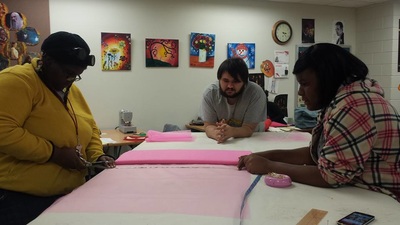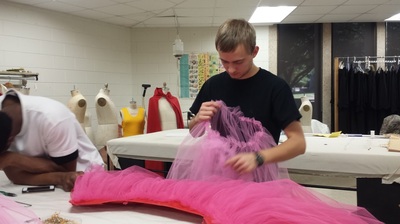The ProcessLongtime MCC choreographer/director Jerry MacLauchlin's recent retirement meant hiring a new dance teacher, Melissa Edwards. As with any new hire, that meant change. For MCC's first ever Fall (and Recover) Dance Concert, student choreographer Keele Halbert, wanted to dress her dancers in tutus while they danced to Melanie Martinez's Dollhouse. In the 18 years I'd worked with Jerry, I'd never made a tutu; fortunately I knew just who to call, MCC alum, Shanna Tucker, cutter/draper at Houston Ballet and expert tutu maker. She immediately emailed me her 6 page instructional pamphlet on the tutu-making process. I needed 5 Giselle style tutus which called for 90 yards of tulle, that's 18 yards per tutu. Each tutu requires 6 layers of tulle. For our purposes, Keele wanted an ombre effect so the bottom two layers were to be red, the middle two layers were to be hot pink, and the outermost two layers were to be light pink. Shanna had strongly advised to invest in a ruffler foot. I happened to find them on sale at a deep 70% off discount at Joanne's so I bought 3 for $36.00 total. We also needed 5 rolls of 1 1/2" wide light pink satin ribbon to finish off the waistbands and keep them tied around the girls' waists. With supplies purchased and measurements taken, the first step was to create the basque or waistband that all six layers would be sewn to. Each one was draped, cut, and serged and then marked in white pencil with six sewing guides at 1/2" intervals down the hip. The red tulle would make up the shortest layers so each strip was cut beginning at 28" on the weft. Four strips were cut at each size. The next layer was also red but cut at 29"; four strips were cut at this size. We switched out the red for the hot pink and cut four more strips at 30" and four more at 31". Last was the light pink: four strips of 32" and the last four at 33". Each bundle of four was pinned together and labeled with the measurement. Bundles were given to the students to sew together on the short side. Three seams later and four strips were turned into one long strip. Seams were pressed open. Each strip was then given to students to ruffle on the largest setting. Once all six strips were ruffled it was time to start sewing them onto the basque. The shortest (28") red strip was pinned and sewn on the bottom-most sewing guide. The next shortest (29") red strip was sewn directly above, followed by the 30" hot pink strip, then the 31" hot pink strip, then the 32" light pink strip, and finally the 33" light pink strip. The tulle was irritating to work with as it got caught on everything and picked up all the loose thread, lint, and other debris that was floating around the shop. The strips then had to be connected to each other to form a skirt. The ends were sewn together from the hem up to 9" from the waist, which left enough room for the girls to get them on. Fittings were done so that closure placement could be marked. Snaps and hooks and eyes were added to close the basque. Finally the satin ribbon was machine stitched to the top edge of the basque directly on top of the last layer of tulle. Once the first one was completed and fitted I realized that the others would have to be much, much shorter. Keele was in the piece and was the tallest girl at 5'8". The other four girls were 5'4" and 5'0. So the next two sets of tulle skirts were cut 4 inches shorter and the last two sets were cut 8 inches shorter. It wasn't a difficult process, but it was easy to get confused as to who was working on what. We made labels with the measurements on them for each piece that was cut and kept them pinned into each piece throughout the whole process so we could keep them straight. Only once did the crew confuse them and sew a longer one onto a shorter girl's basque. Not bad for a shop that had 30 sets of skirts flying around at any one time. The crew were so proud of themselves they took a funny picture in them. I was really pleased with how they turned out and am ready for the challenge of the pancake tutu. Maybe not till next year, though. Gallery
1 Comment
|
CategoriesArchives
July 2024
|
















 RSS Feed
RSS Feed